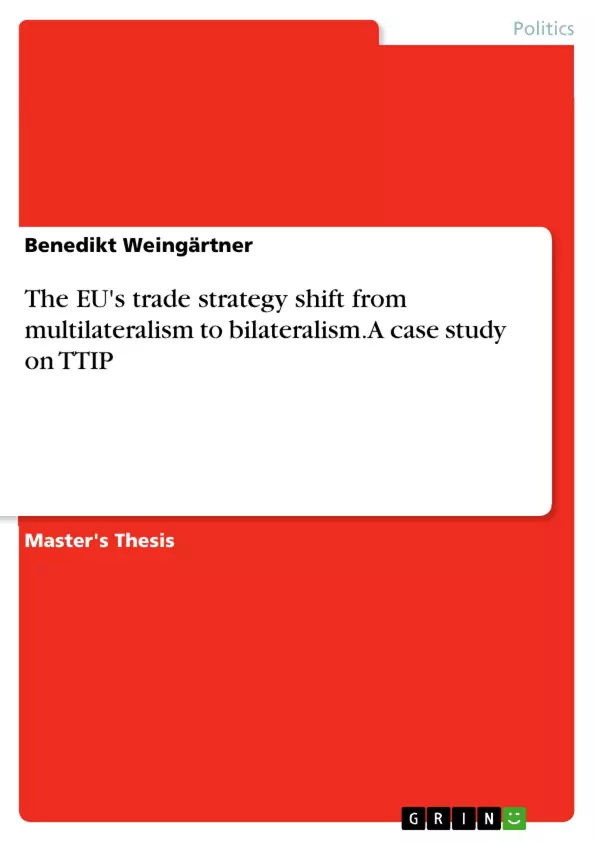Foreign commercial policy represents a major domain of European integration and an exclusive policy competence for the European Union. The strategy, focus and practical approach of this EU trade policy has been continuously adapted to the new circumstances in an ever more globalised world economy. Thus, the EU uses its foreign trade policy not just for mere economic ends but also as a tool to strengthen its global political influence.
Having been a champion of multilateral trade negotiations in the framework of the World Trade Organisation (WTO) throughout the 1990s, the has EU changed this strategic orientation by the mid-2000s shifting its trade policy focus from a multilateral to a bilateral strategy and initiated preferential free trade agreements (FTA) with countries and regions all over the world. Among them, the one with the largest size was the Transatlantic Trade and Investment Partnership (TTIP) with the United States of America, launched in 2013.
Given the huge importance of the EU as a player in global trade, it seems relevant to examine from a political scientific perspective what have been the main reasons, drivers and motivations behind this enormous policy shift. I argue that external factors, domestic interests and institutional dynamics have collectively contributed to the reorientation of EU trade policy from multi- to bilateralism.
I will test this hypothesis by means of three theoretical approaches: neorealism as a systemic theory, liberalism as a theory with a domestic focus and institutionalism to examine the role of the most important EU institution in trade policy, the European Commission.
In order to get a more profound analysis of the main actors and motivations as driving forces of EU trade policy, I will furthermore use a case study on the, both in ambition and size, unrivalled bilateral Transatlantic Trade and Investment Partnership as it, due to its sheer economic and political impact on the both partners involved but also on the rest of the world, provides best significant insights of processes on all three levels of analysis of this paper.
In a nutshell, the global power shift for the benefit of emerging powers and to the detriment of Europe in combination with strong economic interest groups within the EU seeking for market access all over the world as well as self-interests, norms and processes within the European Commission have altogether contributed to the change of course in EU trade policy towards bilateralism.
Inhaltsverzeichnis (Table of Contents)
- Abstract
- Keywords
- List of Abbreviations
- The bilateral shift in EU trade policy, TTIP and its scientific relevance
- Research topic, relevance and methodology
- EU trade strategy: from bilateralism to multilateralism and back.
- TTIP: the climax of EU trade bilateralism?
- Neorealism
- Terms, assumptions and key actors of neorealism
- A neorealist approach to the bilateral shift of EU trade policy.
- A neorealist explanation of TTIP
- Commercial Liberalism – Economic interests and preferences as the main driver of international politics
- Terms, assumptions and key actors of liberalism
- A liberal approach to the bilateral shift of EU trade policy
- A liberal explanation of TTIP
- Institutionalism – Institutions as key actors with self-interest and 'path-dependency'.
- Terms, assumptions and key actors of Institutionalism
- An institutionalist approach to the bilateral shift of EU trade policy.
- An institutionalist explanation of TTIP.
- Conclusion
- Theoretical Conclusions
- Empirical Conclusions
- Broader theoretical implications and policy recommendations
- Bibliography
Zielsetzung und Themenschwerpunkte (Objectives and Key Themes)
The thesis aims to analyze the shift in EU trade policy from multilateralism to bilateralism, focusing specifically on the Transatlantic Trade and Investment Partnership (TTIP) as a case study. The paper utilizes three theoretical approaches: neorealism, liberalism, and institutionalism, to explain the motivations and driving forces behind this policy shift. The objective is to demonstrate that external factors, domestic interests, and institutional dynamics collectively contribute to the reorientation of EU trade policy.
- EU trade policy shift from multilateralism to bilateralism
- The role of neorealism, liberalism, and institutionalism in explaining the shift
- The significance of TTIP as a case study
- The interplay of external, domestic, and institutional factors
- The implications of the shift for EU trade strategy and global trade relations
Zusammenfassung der Kapitel (Chapter Summaries)
- The first chapter introduces the research topic, its relevance, and the methodology employed in the thesis. It also provides an overview of the evolution of EU trade strategy, highlighting the shift from multilateralism to bilateralism and the significance of TTIP as a landmark example of this trend.
- Chapter two delves into the neorealist approach to international relations, defining its core terms and assumptions. It then applies this theoretical framework to analyze the bilateral shift in EU trade policy, focusing on how the changing global power dynamics and the pursuit of national interests have shaped the EU's strategy.
- Chapter three explores the liberal perspective on international politics, emphasizing the role of economic interests and preferences. It examines how domestic pressures from economic interest groups and the pursuit of market access have influenced the EU's embrace of bilateral trade agreements.
- Chapter four focuses on the institutionalist approach, highlighting the role of institutions in shaping international relations. It analyzes how the European Commission, as a key actor in EU trade policy, has contributed to the shift towards bilateralism through its own institutional dynamics, norms, and self-interest.
Schlüsselwörter (Keywords)
This paper focuses on the key areas of EU trade policy, bilateralism, multilateralism, the Transatlantic Trade and Investment Partnership (TTIP), and the theoretical approaches of neorealism, liberalism, and institutionalism. It examines the drivers and motivations behind the EU's shift towards bilateralism, highlighting the interplay of systemic, domestic, and institutional factors.
- Quote paper
- Benedikt Weingärtner (Author), 2017, The EU's trade strategy shift from multilateralism to bilateralism. A case study on TTIP, Munich, GRIN Verlag, https://www.grin.com/document/369434



